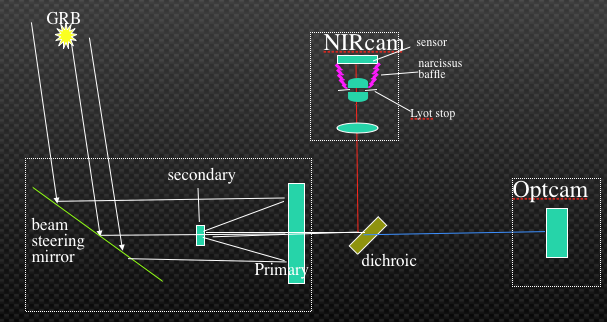NGRG Instruments
- Bruce Grossan of the University of California Space Sciences
Lab

Overview
The NGRG is made up of
- Coded Mask X-ray Camera
- Beam-Steering System
- Telescope
- Cameras - Opticam & NIRcam

The sketch above shows a few key features of the NRGR OIR system, especially the camera system. The telescope beam is split by a dichroic into an optical beam (covering most of the CCD sensitive range) and a NIR beam (cut off for mirror thermal background) to a NIR camera with a Lyot stop and an H2RG (HgCdTe) sensor.
|
The paper lays out the functional characteristics of these types of instruments, and using real measured characteristics of instruments predicts performance and event detection rates using mostly performance scaled to that of BAT and UVOT (not calculated). We did this to get realistic space backgrounds and realistic duty cycles due operational issues and etc. So, we present conceptual design, not e.g. materials and dimensions.
Coded Mask X-ray Camera
Swift-BAT is a great instrument; Burrows+12 http://arxiv.org/abs/1106.0749 suggests that coded mask instruments are essentially optimum for GRB detection rates. The NGRG Xcam has a similar design and function, however we prefer some more modern options...
- Modern low-energy detectors (e.g. silicon detetcors like on Janus; Burrows+12 http://arxiv.org/abs/1106.0749) get a lot more photons because of negative log slope GRB spectra (and the background down to ~ few KeV is not much worse, so you really win on SNR).
- Given enough power and money, however, moderately cooled (e.g. -30 C) CdT or CZT detectors yield response down to 4-5 keV, giving the best of all possible worlds (http://arxiv.org/pdf/0807.0738.pdf).
Where is the NGRG-XRT? - We don't have a focused X-ray telescope. Chandra or Swift or whatever other instrument can do this for us. They do afterglows, we do prompt, and we are trying to be of modest cost.
OIRTel Optical-IR Telescope
R-C telescopes with good performance from optical-NIR are pretty standard.
The only tricks here are maintaining focus on-orbit without heaters which are not freindly to the IR observations.
Cameras - Opticam & NIRcam
Transient observations are much, much more useful when they are simultaneous, so we use a dichroic to allow both to view the GRB simultaneously. (If only we could have all the bands we wanted on a small satellite!).
Beam-Steering System
Our Beam-Steering System is very simple; just a two-axis gimbal mirror driven by electric motors. Off-the shelf direct drive digitally controlled motors are already good enough for 0.1" encoder precision and active feedback control.
The only tricks are
- careful engineering design so mirror vibration makes < 1" smear in < 1 s
- use a very lightweight mirror for minimum moment of inertia
- hire a good engineer so the active feedback really works
Swift: > 60 s response time. |
NGRG: ~ 1 s Response Time |
Swift Response Time is Finite, and Misses the Rise Phase of Most GRBs. |
The NGRG beam-steering mirror is designed to be observing in ~ 1 s. |
I
What good is NIR? Why do you need both Opt, NIR?
The majority of bursts are extinguished (look at Perley+09). Therefore, to have a good systematic understanding of GRB, you have to be able to probe some distance into the parameter space of extinguished bursts. This is more easily done with NIR emission, which helps to look at redder wavelenghts, where the extinction is less. I am very excieted about the NGRG's ability to dynamically observe dust destruction. By measuring an optical to NIR color of the emission with rapid response, you see the effects of dust extinction change as the dust is evaporated; this is only possible with two colors, preferably including NIR, and only possible with rapid-response (the entire process is believed to be over in ~ 60 s).


Dr. Bruce Grossan
Mailing Address:
Lawrence Berkeley Lab 50R-5005
1 Cyclotron Road
Berkeley, CA 94720
Office Location for visits: 50-5005D
bruce [at] singu[dot]lbl[dot]gov [anti-spam format address]
![[PHONE]](../phone.xbm) 510.486.5489 510.486.5489
Fax 510.486.7149
Mail comments to bruce [at] singu[dot]lbl[dot]gov [anti-spam format address]
Last Update: 2014 Feb 21 |



